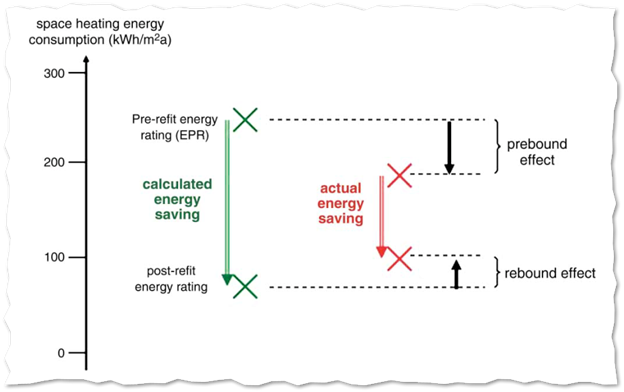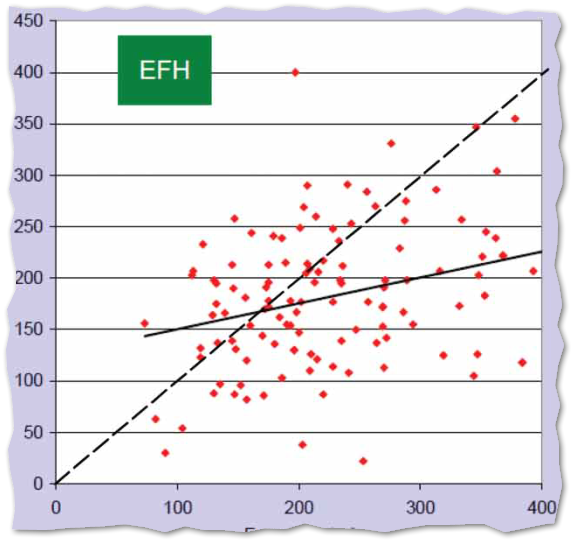“A Passive House uses 90% less energy for heating and cooling compared to a Code-minimum house!” A not uncommon statement. It is theoretically correct, but only with fine print qualifiers. As designers and advocates of Passive House, we need to get more nuanced about how we describe energy savings. This is particularly important as we approach deep energy retrofits because payback periods are long, if you’re just calculating in dollars.
Let’s take a statement like “Building to the Passive House standard uses 81% less energy than is used to heat a typical single family home in Auckland to 20C (and 92% less than one in Christchurch)”. I’ve written that in the past. But the energy savings only apply if the standard thermally-inefficient home were also being heated to the same level of comfort. In the leafy suburbs of Auckland, it may be the case that retrofitted gas-fired central heating is keeping draughty old villas at 20C all winter long, and homeowners are stumping up a thousand dollars a month in energy bills.
But this is not the typical experience. Most people in thermally inefficient houses aren’t using all the energy it would take to keep their poor quality home at a healthy, comfortable temperature. Instead they are cold: to the detriment of their health and sometimes the integrity of the building structure.
As designers we need a way to explain potential energy savings to our clients. It’s not uncommon to see predictions of projected energy savings of 200 kWh/m²/year for heating a 180m² home in the colder parts of the South Island. Sustainable Engineering does this too when we create energy models! Because there is no other viable means of stating comparison. Our reports make sure to include the caveats. As professionals, it’s easy to lapse into shorthand that doesn’t include that nuance. We have to make sure our clients get it.
People will not see savings of this magnitude if they are not spending money on adequate heating in the first place. Let’s dig into the intersection between human behaviour and building science to understand why the base level assumptions about energy use in thermally inefficient houses can be wrong.
Prebound effect
The answer lies in a phenomenon called the prebound effect, coined by researchers Minna Sunikka-Blank and Ray Galvin in 2012. Their brilliant paper analysed data from 3400 German homes and found that, on average, the occupants were using 30% less heating energy than the home’s official energy performance rating (EPR) predicted. “Prebound” refers to the energy that was never actually consumed before the retrofit (dubbed prebound in response to the more widely understand rebound effect).
The worse the energy efficiency of the house, the bigger this gap became. For instance, a house with a terrible rating of 300 kWh/m²/year was likely to have an actual consumption 40% below that calculated value. This is because people aren’t stupid. They aren’t going to spend a fortune on heating in a doomed effort to maintain a leaky tent at a balmy 22°C. They put on two jerseys, heat only one room or just put up with being cold. They are “pre-saving” energy that our models assume they are using.
And rebound
Then there’s the flip side: the rebound effect is more widely understood. After a deep retrofit, when the house is cosy and cheap to run, occupants tend to consume a bit more energy than the new, improved rating would predict. They heat to 22°C and not the 20°C the model assumes. They take some of the savings back as increased comfort, which is perfectly reasonable. This explains why lightweight retrofits for energy efficiency don’t help much when it comes to reducing heating and cooling demand to a level that will actually help reach climate change mitigation goals.
The combination of these two effects means the actual energy savings are often squeezed from both ends, as this schematic from Sunikka-Blank and Galvin’s paper neatly illustrates:

Figure 4 from Sunikka-Blank & Galvin (2012) shows how the actual energy saving is reduced from the theoretical by both the prebound and rebound effects.
So when we calculate a huge potential “saving”, we’re comparing the theoretical use of a bad building with the theoretical use of a good one. The reality is that the occupant’s starting point is much lower (the prebound effect) and their finishing point is a little higher (the rebound effect).
This isn’t just a German quirk. The paper notes similar findings in Dutch, Belgian, French and UK studies. The desire to be warm is a human behaviour that crosses cultural and national boundaries.

Figure 1 from Sunikka-Blank & Galvin (2012) shows measured energy consumption on the vertical axis and calculated energy consumption on the horizontal. The solid black line is the averages.
Data like that which is graphed above is very interesting and I’ve done some initial research into whether this average fit from large European data sets could be applied to New Zealand. Unfortunately, it appears overseas data isn’t relevant, even when we ensure we are comparing equivalent climate zones. Why? Because New Zealanders are world leading in their thriftiness and capacity to endure underheated homes. My sample size was small but it included homes built to different levels of energy efficiency. The Auckland houses in the sample that were built to recent Building Code standards were using virtually no energy for space heating but this is not a good news story because these same dwellings were cold.
I am always annoyed when people say ‘oh but it’s different in New Zealand’ as if that’s a reason not to build better. There’s not some secret force field at our boundaries that warps building physics just for us. What is true is that people are different and there is a cultural difference in New Zealand with regard to tolerating horribly cold houses. I’ve lived here 16 years and I still don’t understand you all. We came up with some hypotheses in my first book (see the sidebar Why do we put up with it? in the first chapter, which you can read online here). If anyone has any advances on these theories, please let me know.
What retrofits really deliver
As designers, we must keep in mind that using a building’s energy rating to predict energy and CO₂ savings will likely overestimate the actual savings and underestimate the real payback time. Let’s not try and sell deep energy retrofits on financial numbers. We aren’t just making a building more efficient; we’re usually moving a household from a state of fuel poverty and thermal discomfort to one of health and comfort. The energy reduction is real, but it’s the gap between their actual pre-retrofit use and their actual post-retrofit use. Let’s be honest with our clients and ourselves about what we are actually saving: money, yes, but more importantly, we are delivering comfort and health that was never there before.
Abstract
German regulations for the thermal renovation of existing homes demand high thermal standards, which the government claims are technically and economically feasible. This paper examines existing data on 3400 German homes; their calculated energy performance ratings (EPR) are then plotted against the actual measured consumption. The results indicate that occupants consume, on average, 30% less heating energy than the calculated rating. This phenomenon is identified as the ‘prebound’ effect and increases with the calculated rating. The opposite phenomenon, the rebound effect, tends to occur for low-energy dwellings, where occupants consume more than the rating. A similar phenomenon has been recognized in recent Dutch, Belgian, French and UK studies, suggesting policy implications in two directions. Firstly, using a dwelling’s energy rating to predict fuel and CO2 savings through retrofits tends to overestimate savings, underestimate the payback time and possibly discourage cost-effective, incremental improvements. Secondly, the potential fuel and CO2 savings through non-technical measures such as occupant behaviour may well be far larger than is generally assumed in policies so policy-makers need a better understanding of what drives or inhibits occupants’ decisions.
Reference
Sunikka-Blank, M., & Galvin, R. (2012). Introducing the prebound effect: the gap between performance and actual energy consumption. Building Research & Information, 40(3), 260-273. https://doi.org/10.1080/09613218.2012.690952